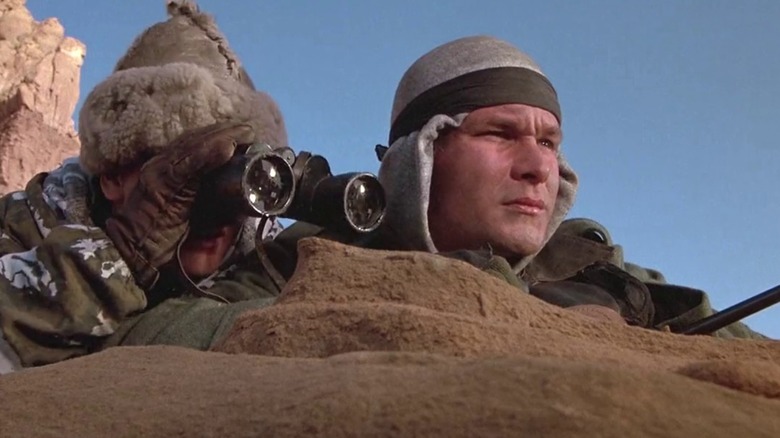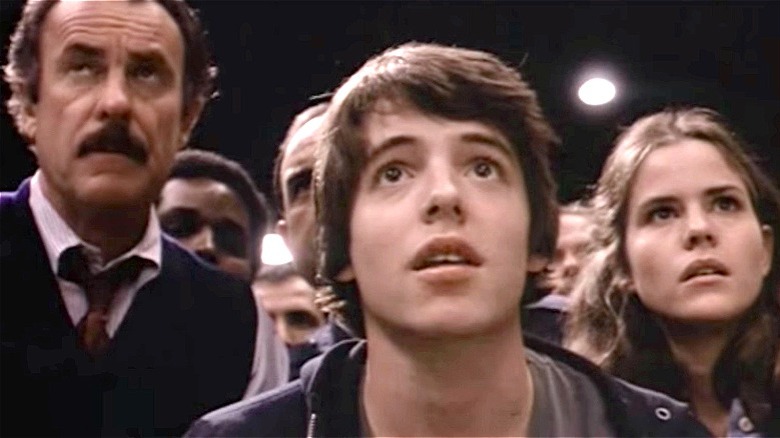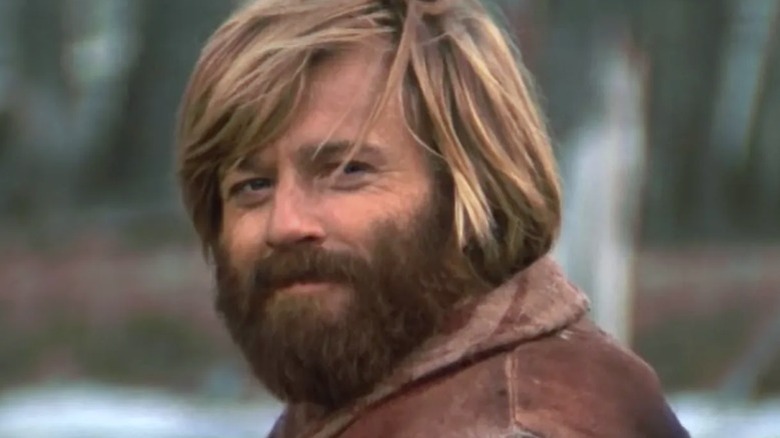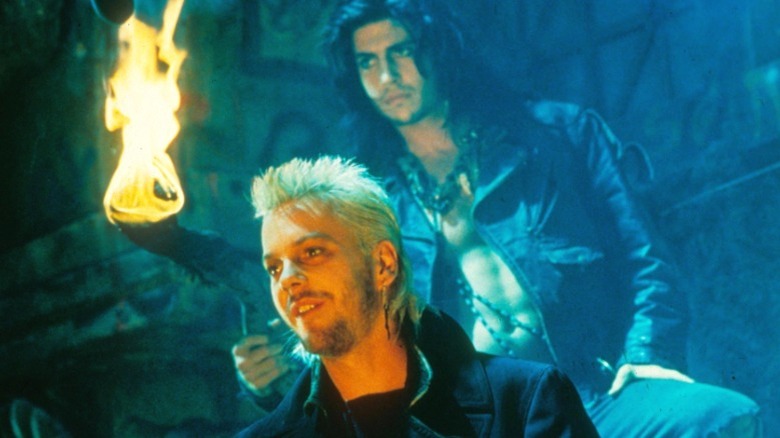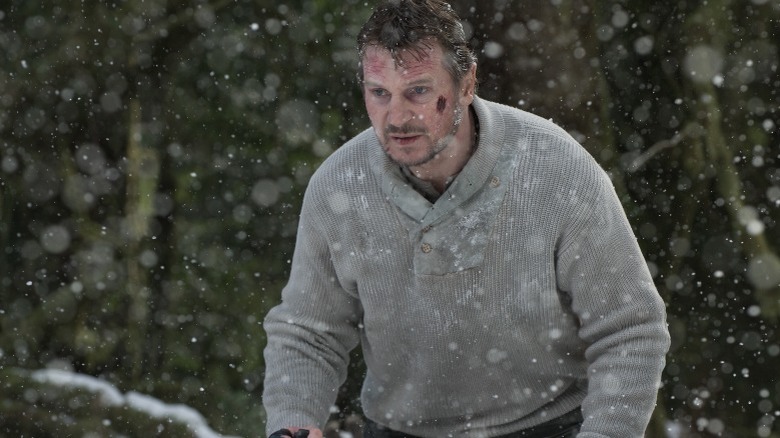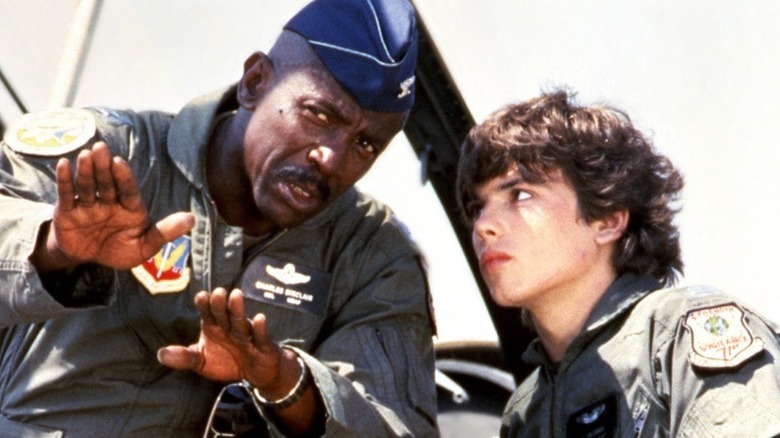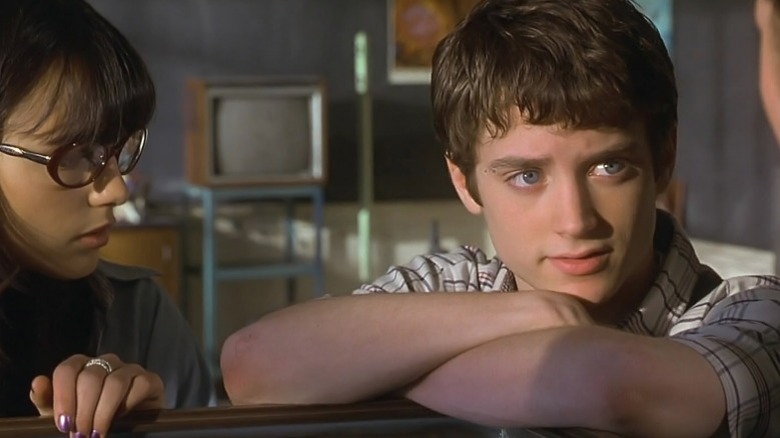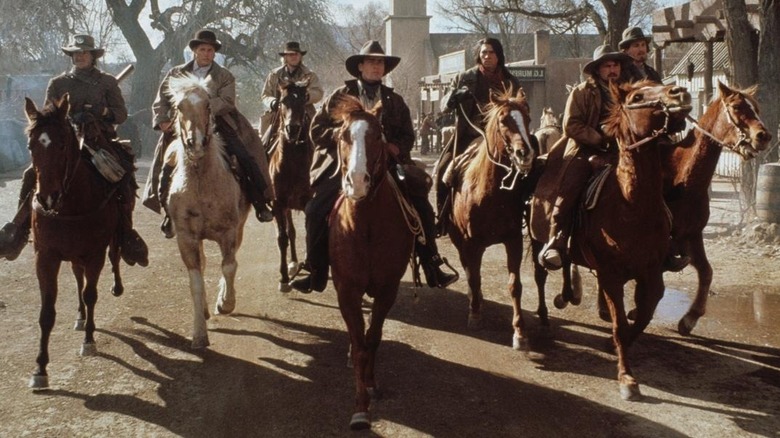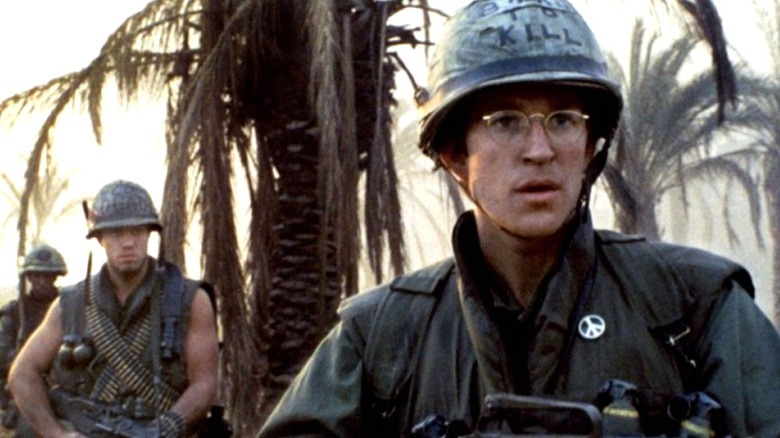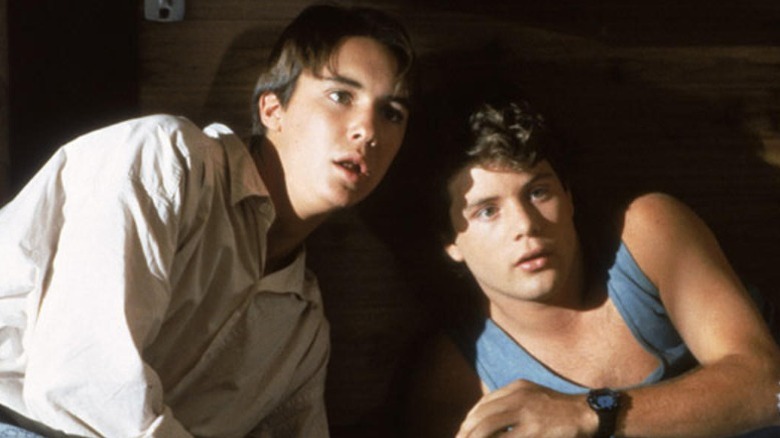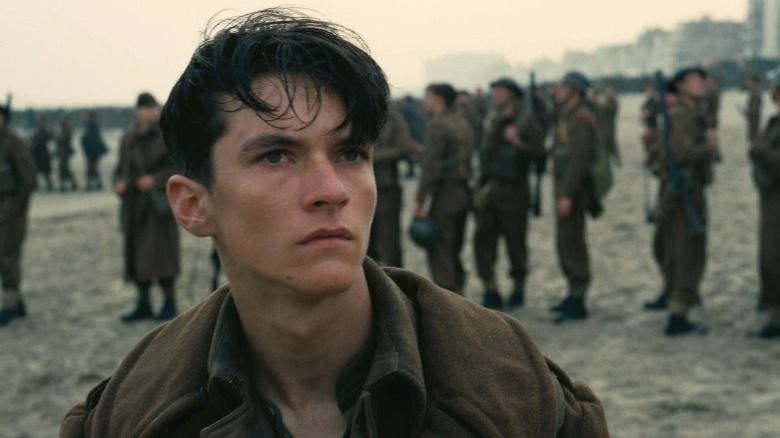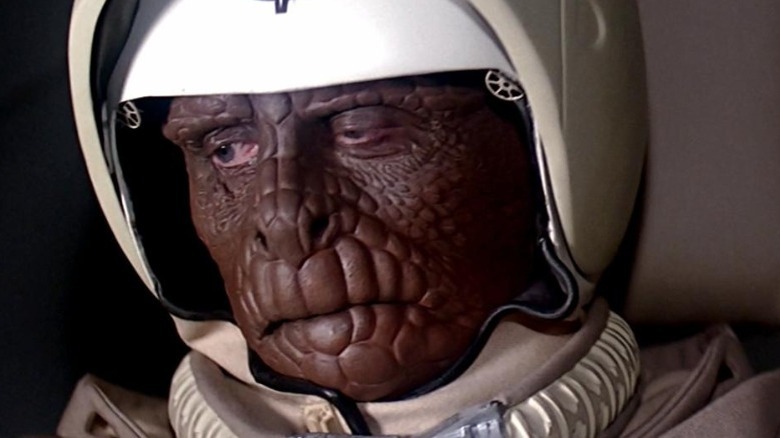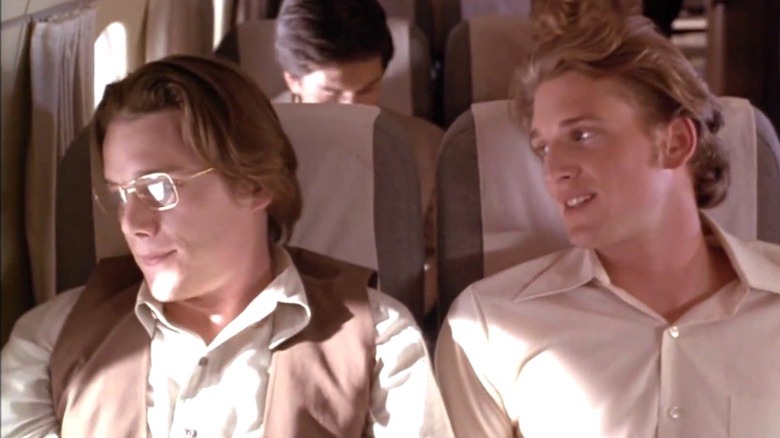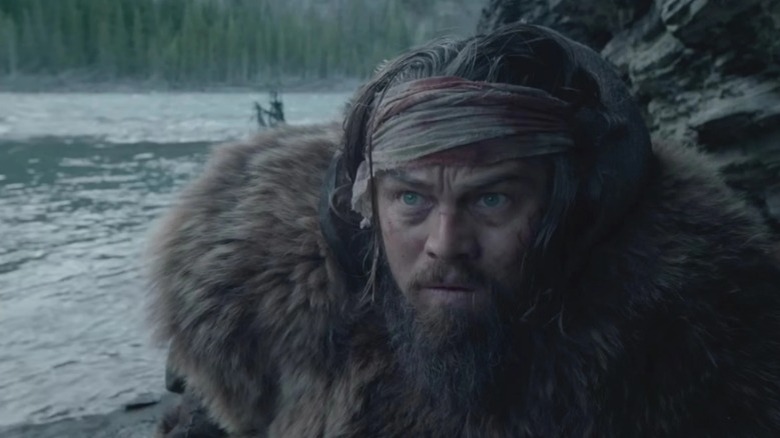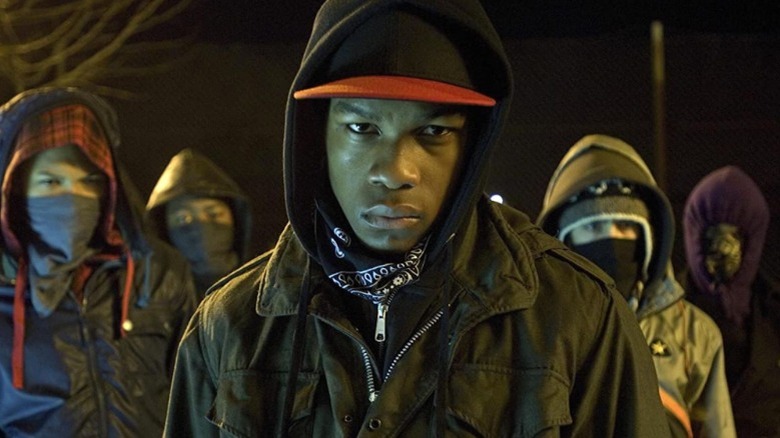Movies Like Red Dawn That You Need To Check Out
The year 1984 offered a bumper crop of cult classics that haven't aged well, yet thrive in our hearts. "Red Dawn," starring Patrick Swayze and Charlie Sheen, is a deep-fried mozzarella stick of action joy, a thriller that pits a mob of high schoolers against an enemy invasion. The specter of the Cold War and '80s Communist alarmism fuels the film's deadly Russian threat that seeks to take over America by force. A 2012 remake lost what was special about "Red Dawn," up to and including Swayze's dark gold baby mullet.
"Red Dawn" works not because it's beautifully stupid (it is), or because of its vague geopolitics, but because it successfully pulls from some great, classic tropes. There's the allure of the Western standoff, the drama of youth forced into mortal combat, and let's not forget the rugged individualism, that core of the American survival movie. There's not much out there that's like "Red Dawn," but there are plenty of movies that touch on part of why it works. We have 14 movies for you that will scratch a little of that itch, flicks that are either just as fun as "Red Dawn" or showcase the grim reality behind its guerrilla war scenario.
WarGames (1983)
Like "Tron" and its vision of life inside our computers, 1983's "WarGames" is a little confused on the particulars of government security, but it's got the right spirit. Our teenage hero, Matthew Broderick, is one of the first movie geniuses to grasp the power of computer hacking and its predecessor, phreaking, and the film portrays these details accurately. His aims aren't grand, he's just out to have fun, fix his grades, and maybe cadge some free long distance. However, his scans of the fledgling internet connect him to NORAD's baby AI, WOPR (War Operation Plan Response), and then the humorless men in dark suits show up.
WOPR just wants to play a game, but "WarGames" sets out to teach the audience about the GIGO principle. Garbage in, garbage out, aka, user error. WOPR is an incredibly intelligent AI, but it was never taught the difference between a scenario and reality before NORAD plugged it into its mainframe. That it takes a plucky teenage hero to stop nuclear war before it happens is a bit much, but you should know that three months after this film came out a similar scenario played out in Russia, and was stopped by one man.
Jeremiah Johnson (1972)
There's a crusty, bearded king of the survival movie, and his name is "Jeremiah Johnson." Robert Redford is capable of carrying whole movies by his lonesome, as he did in 2013's "All Is Lost," but his skills were honed by starring in this vaguely-true tale of mountain men doing manly things in the unspoiled West. The allure and loneliness of Johnson's life is pockmarked by encounters with a fellow mountain man (who teaches him how to navigate the cruelties of a wild life), a woman and her son, and the local Indigenous tribe. It's a forlorn, often stirring movie co-penned by "Red Dawn" filmmaker John Milius, and bear in mind that it does rely on the misunderstandings and racism of the Old West.
The truth of Jeremiah's tale is mixed. Once there was a man called Liver-Eating Johnson, and he built a life for himself in the wilds of 1880s Montana. The rest is folklore, and the Crow tribe Johnson famously beefed with has vague records of a fella that came around sometimes. The Raymond Thorpe and Robert Bunker book "Crow-Killer" will flesh out the Redford film for fans, but get a new edition, with prefaces that add better context to Jeremiah's legend.
The Lost Boys (1987)
There's a lot of great subtext to study in the classic vampire flick "The Lost Boys." The intense way Jason Patric focuses on Kiefer Sutherland over designated love interest and lost waif Jami Gertz is as fetching as "Top Gun" and its beach volleyball sequence. It also more than makes up for the surprising lack of such subtext in "Red Dawn." Meanwhile, a squad of teenagers have to fend off slightly older-looking teenage bloodsuckers, who are eternally stuck in their "big eater" phase. Fortunately for the vampires, their city is a walking buffet.
"The Lost Boys" is sometimes an effective product of its time. Watching '80s TV and film leaves the impression that increasing violence and lost children were real fears to its intended audience, which they were at the time. The dozens of "have you seen this person" posters that litter the walls of the fictional Santa Carla fed from the stories out of New York City and Los Angeles. Today, it's just good fun.
The Grey (2011)
It's both a little iffy and completely awesome that a movie exists where Liam Neeson is going to have to punch up some wolves during his last stand. That actual rock-em sock-em goes mostly unseen, as this melancholy survival drama is invested in the value of faith when the last hope begins to gutter out. "The Grey" sets up some surprisingly intricate groundwork for discussion, but if you also just want to watch some roughnecks fight nature itself, this flick is for you.
Liam Neeson makes the film work beyond the wildest dreams of its script, but for a heartbreaking reason. One of a number of films Neeson threw himself into after the loss of his wife, "The Grey" is arguably his best. It validates his anger as his pain comes through the screen in ragged, vivid bursts. It's up to you if the movie is about faith, depression, or something else, but the trudge through this beautiful, frozen landscape is worth figuring it out.
Iron Eagle (1986)
"Iron Eagle" had the misfortune to come out the same year as "Top Gun," but that's only the first of this glorious cheeseball movie's many problems. The premise is so absurd that the real Air Force refused to offer support to the film's production. Doug (Jason Gedrick) is a teen when his dad is shot down in enemy territory, and like every kid with a dream, he comes up with an idea to infiltrate a U.S. Air Base with the help of a retired officer, rip off a couple jets, and go rescue Pops himself from The Enemy. The movie has the taste to headquarter its generic, Middle Eastern-themed foes in a fictional country, but that fictional country is literally Libya with the "L" and the "B" transposed to make "Bilya."
The saving grace of the movie is Louis Gossett Jr., who is clearly aware of the kind of movie he's in and sets out to be the best part of it. It works, and his honest talks with the emotional Doug hit better than Tom Skerritt's "Top Gun" chats with Tom Cruise.
The Faculty (1998)
The best way to adapt the gleeful absurdity of "Red Dawn" is to amp the premise into something so improbable that it gains a paradoxical legitimacy. The result is Robert Rodriguez's "The Faculty," the best movie to pit a pack of high schoolers against an alien invasion, bar none. It's also a terrific metaphor for kids struggling to retain their individuality against the uniformity of the American school experience. As a bonus, it has Jon Stewart in one of his rare acting gigs, obviously having the time of his life.
The movie has the nerve to make the school's drug lord into its version of Kurt Russell's MacReady from "The Thing," and it pays off. The emotionally distant, too cool for school Zeke (Josh Hartnett) ensures the movie's most obvious lift from John Carpenter's horror classic — take this test to prove you're human — comes off as tone-perfect homage, not a ripoff. Overall, "The Faculty" remains one of the best of its kind.
Young Guns (1988)
Like "Jeremiah Johnson," truth is rarely allowed to get in the way of a good story. Yet 1988's "Young Guns," unlike its predecessor, has a surprising amount of historical veracity to it. Billy the Kid, one of the Old West's most well-known outlaws, is envisioned here as Emilio Estevez, a young blond hottie who builds a team out of some of the decade's other hotties. Together they become the Regulators, a band of deputized outlaws meant to support John Tunstall in his Boba Fett-style usurpation of Lincoln County, New Mexico.
History buffs know this won't go well, and the long-term impact of the Lincoln County War is mostly brushed over. "Young Guns" instead focuses on the character dynamics of this good looking outlaw team and their rootin' tootin' cowboy shootin'. Assuming that's what one's signing up for in their movie of choice, "Young Guns" is a great ride through the West that was.
Full Metal Jacket (1987)
At some point, someone might watch "Red Dawn" and ask themselves what a realistic version of that might look like. Emotionally damaging war movies have our answer! "Full Metal Jacket" is the cynical gold standard of what it's like to prepare to send young people off to war, notably a war we had no business being involved with.
Stanley Kubrick's film is set up like a two-part novel, and the transition can be jarring for first-time viewers. Part one, at boot camp, is a vicious look at the use of conformity and abuse to prepare these kids for the horror of war. Part two sees the recruits in the streets of Vietnam, where that dehumanization pays off in the blank, hateful stares of men like Animal Mother (Adam Baldwin). The soldiers of this movie would have few problems fending off an attack on their home streets of the United States. The problem is how they'd treat their neighbors after the shooting was done.
Toy Soldiers (1991)
There is one film that's closer to "Red Dawn" in spirit than most. "Toy Soldiers" pits a prep school against a terrorist incursion, but adds a touch of "Home Alone" to the proceedings. It's a messy film with a by-the-numbers plot in most respects, but the shockingly good cast turns the film into a great popcorn fest. The adults are reliable fare, with "Iron Eagle" star Louis Gossett Jr. making a surprise second visit to this list, and "Full Metal Jacket" drill instructor R. Lee Ermey on board in fine fettle as his usual hard-nosed military self.
The heart of the film, though, belongs jointly to Wil Wheaton and Sean Astin. "Star Trek" fans can roll their eyes at Wesley Crusher all they want, but Wheaton was one of the best child actors of the modern era, and he doesn't phone it in here. Backing them up is the underrated '80s teen comic Keith Coogan, here acting as a spiritual ancestor to Hogwarts' prank-loving Weasley Twins.
Dunkirk (2017)
Christopher Nolan's "Dunkirk" is a fine companion piece to "Full Metal Jacket." The events of Operation Dynamo were a kind of reverse-Normandy, and another large-scale horror that shapes our memories of World War II. Trapped Allied troops had to be evacuated from the beaches of Dunkirk before Hitler annihilated them, and the odds were terrible. Yet perseverance and luck brought forth a miracle, and Nolan's film is one of the finest ground-level recollections of the struggle ... If you can understand what anyone is saying without subtitles on.
Fortunately, "Dunkirk" is light on critical dialogue during the noisiest sequences. Visual empathy and an ensemble of key characters guide us through the film effectively enough. Our first protagonist, Tommy Jensen, is another potent reminder that the sights of war first scar our young. The film flows neatly between the tripod of war (land, sea, and air), culminating in a dazzling mix of hope and despair. I may have my issues with Nolan, but as war movies go, this one is top shelf.
The Last Starfighter (1984)
Nothing is ever universal, but the childlike urge to drift into daydreams where you step up as the hero in scenarios varying from the mildly probable to the impossible is a huge part of our human experience. "Red Dawn" is a variant of this kind of fantasy, one that's gotten a little warped out of shape today by prepper/survivalist culture and other social complexities. "The Last Starfighter" is its wilder counterpart. Of course this kid's twitch reflexes and video game experiences are just what the galaxy needs to fend off the Kodan Armada. God, I wish that was me.
The genius of "The Last Starfighter" is how well it understands the way that fantasy resonates with us. Alex Rogan (Lance Guest) isn't just a kid with a daydream. Alex needs that daydream to survive, as he has so few opportunities in his real life that his looming adulthood already seems doomed. It's poignant stuff, and maybe a little bit too on-the-nose relevant today. The good news is that the effects still hold up while you're watching this in an existential depression!
Alive (1993)
Not every survivalist story is a hopeful one, as "The Grey" already proved, but sometimes reality is harsher than anyone was prepared for. "Alive" is the dramatization of the Uruguayan Air Force Flight 571 crash, and what it took for 16 passengers to ultimately survive. Ethan Hawke plays the real-life rugby player Nando Parrado, one of two young men to hike deep enough into Chile to find rescue.
The movie errs on the side of caution about one of the secret keys that helped these people survive, and while that choice weakens the movie, it's understandable. Like a handful of other grim survivalist tales, these stranded victims eventually resort to one of the most taboo acts we have as a species, cannibalism. The movie doesn't focus long on the actual consumption, but it does highlight the torment the survivors go through. It's a weight the real-life survivors carried with them, and at no point does the film treat the issue as a joke.
The Revenant (2015)
My heart belongs to "Jeremiah Johnson," but we'd be amiss to ignore the movie that finally got Leonardo DiCaprio his Oscar. "The Revenant" is a fresh take on Hugh Glass, another old folk hero of the West that was. Sumptuously — and painfully — filmed in distant locales with natural lighting, the result shows off the hidden viciousness of nature's bounty, just as its human cast deals with their own feral natures.
"The Revenant" isn't only a survival movie. It puts revenge front and center, not afraid to look close at the moments that put Glass (DiCaprio) in a rage. There's plenty of satisfaction in watching Glass whittle down his opponents, who left him for dead and turned him into the titular revenant. The French trappers are rapists and murderers, and Tom Hardy is a little too good at being utterly loathsome here. Like "Mad Max: Fury Road," a tough shoot turns Hardy into the right foil for everyone else around him.
Attack the Block (2011)
There's an underrated competitor in the field of "teens having an extremely weird time of it," and it's the British indie "Attack the Block." Best known for introducing future Star Wars-er John Boyega to the handful of Americans who actually saw this clever wisp of whimsy, Joe Cornish's flick pits a teenage street gang against an alien invasion. It's also the film that predicted the rise of Jodie Whitaker, almost a decade before she took her turn as The Doctor. Nick Frost, best known from Edgar Wright's Cornetto Trilogy, is also here to help introduce American audiences to the social intricacies of England's version of public housing. Hint: It's as much a mess there as it is across the pond.
The alien designs are especially neat, blending primate physiology with plain 'ol unnerving critters. It's all cheekily knowing, as the fictional Wyndham Tower where much of the action takes place is an homage to John Wyndham, the writer who gave us "The Day of the Triffids" and "The Midwich Cuckoos." Like Wyndham's works, "Attack the Block" hides apt social commentary inside a romp that's just plain fun.
